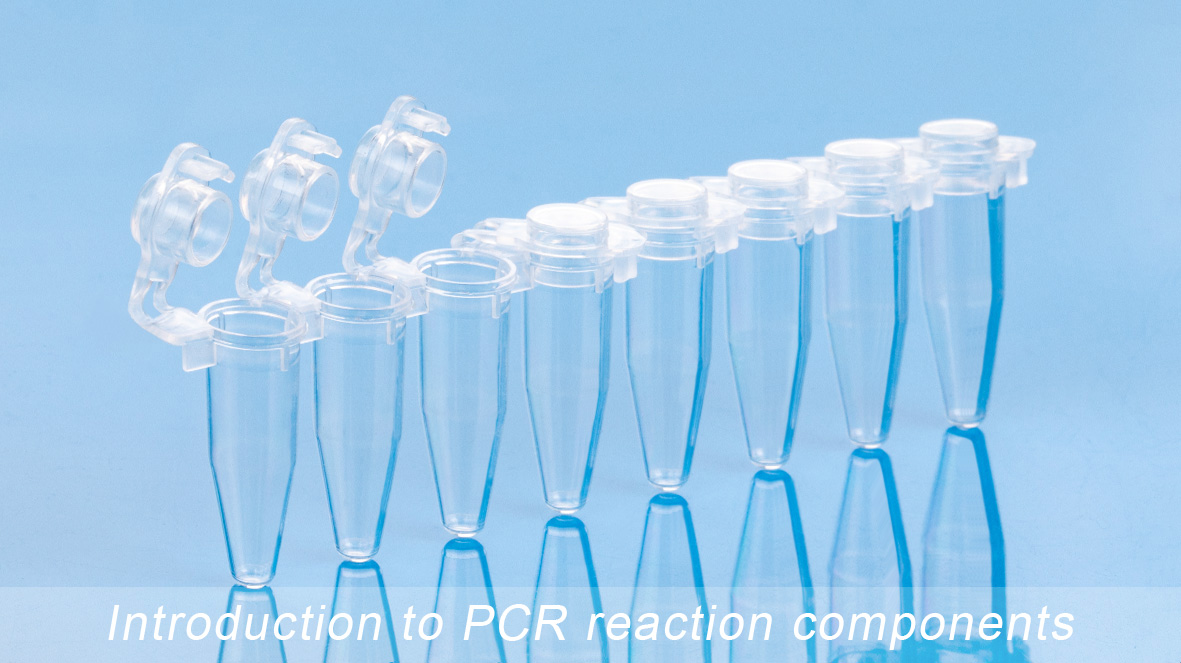Table of Content
As we all know, PCR technology is the mainstream technology of molecular diagnosis at present, and its raw materials are PCR reaction components (enzyme, dNTPs, primer, buffer) in addition to templates. In order to improve the performance of PCR, people usually focus on enzymes and buffers after designing primer sequences. Next, we will make a simple overview of each component, if there is any deficiency, please give us more advice.
Catalog
- Market Scale of Molecular Diagnosis
- Commun molecular diagnostic techniques
- Principles of PCR Technology
- The key raw materials of PCR technology
- Special premix in PCR technology
- The future development trend of PCR technology
Market Scale of Molecular Diagnosis
In 2019, the market scale of nucleic acid testing was 8.5 billion dollars, China was 10.6 billion yuan, which accounted for 18% of the world. In the past three years, the global nucleic acid testing market has grown at a rate of 4%-6%, and China at 18%-19%. The growth rate of China’s nucleic acid testing market has led the world.
According to the compound annual growth rate of the past six years, the global nucleic acid testing market will reach 12.2 billion dollars in 2025, and China will reach 26 billion yuan in the same period.

The developments of the main techniques of molecular diagnosis

Main Techniques of Molecular Diagnostics

Principles of the PCR technology
1. Establishment of DNA double helix structure model
Waston JD and Crick FHC’s “double helix model” started the development of molecular biology and recombinant DNA technology. This model establishes nucleic acid as the foundation of information technology; it is proposed that base pairing is the basic way of nucleic acid assisted transmission of genetic information, and finally, it confirms that nucleic acid is the material basis of heredity.

2. DNA Replication Model

3. PCR
PCR, also known as polymerase chain reaction, refers to the process of in vitro replication of daughter STRAND DNA complementary, under the catalysis of DNA polymerase, to mother strand template DNA through denaturation, annealing, extension and other steps, using parent strand DNA as template DNA and specific primers as extension starting point. This is an in vitro synthetic amplification technique that enables rapid and specific amplification of any target DNA in vitro.

4. Semiconservative replication, exponential amplification

PCR technology used in the IVD

1. Non-specific fluorescent labeling: dye method
1.1 Advantage
- No selectivity for DNA template-suitable for any DNA template
- Easy to use-no more complicated probe than design
- Very sensitive
- Can be used for welding curve
- Cheap
1.2 Disadvantage
- High requirements for primer specificity
- Combining with non-specific double-stranded DNA to produce false positives
- The primer sequence needs to be specially optimized to avoid the appearance of primer-dimers
- Mainly used in scientific research

2. Specific fluorescent labeling: probe method
2.1 Advantage
Extremely high specific nuclear accuracy: In addition to the specificity of the primer sequence, the probe method also has the specificity of the probe sequence, which guarantees the specificity and good repeatability of the amplified gene from two aspects
2.2 Disadvantage
- The synthesis price of the probe method is higher
- Can’t do melting curve analysis

2.3 Features of Taqman probe:
- The 5’end is marked with Reporter, R, such as FAM, VIC, etc.
- The 3’end is marked with Quencher, Q
- The probe is complete, the fluorescence energy emitted by R is absorbed by the Q group, no fluorescence, R and Q are separated, and fluoresce
- Taq enzyme has 5’→3‘exonuclease activity and can hydrolyze the probe

The key raw materials of PCR technology

The main raw material of PCR technology
1. Primer:
Normally, the length of the primer is 15~30bp, the end of the primer 3’ is best to choose A, C, G, the primer G+C accounts for about 45~55%. To avoid the hairpin structure in the primer and the dimer between the primers, it cannot have the homology with the non-target amplified region.
2. Probe: Taqman principles of probe design

3. dNTPs:
With strong acidity, its storage liquid is generally adjusted to pH 7.0~7.5 by NaOH, the general storage concentration is 10mM, the composition of the same amount of configuration, reaction concentration is 20~200uM.
4. BSA:
Acetylation of BSA can reduce the adsorption of PCR tube on Taq enzyme, which protect Taq enzyme.
5. PCR Enhancer:
PCR Enhancer is a kind of mixed additive composed of various components. In PCR reaction, PCR Enhancer can effectively reduce the unchain temperature of high GC template and template with complex secondary structure, greatly reduce the influence of DNA secondary structure on PCR, and increase the sensitivity and specificity of PCR reaction. Besides, it is compatible with almost all DNA polymerase amplification systems.
It is mainly composed of DMSO, Betaine, formamide, TMAC, trehalose, BSA, Tween-20, NP-40, TritonX-100, PEG, spermidine, glycerin, single strand DNA binding proteins or mixtures thereof.
The key raw material of PCR technology
1. Warm boot Taq DNA polymerase

2. Other DNA polymerases
High fidelity Pfu polymerase
- The fidelity is 8-10 times that of ordinary Taq enzyme.
- Amplicon up to 5kb can be produced.
- It had 3′-5 ‘corrected exonuclease activity with an error rate of 3.0×10-6.
BST enzyme
- BST 2.0 and BST DNA polymerase large fragments are mainly applicable to isothermal amplification (LAMP) of DNA templates at 60-65 degrees.
- BST 3.0 showed good reverse transcriptional activity between 60 and 65 and could be used for single tube RT-LAMP.
RPA enzyme
- Recombinase polymerase amplification, RPA.
- RPA techniques rely on three enzymes: recombinases that bind single-stranded nucleic acids (oligonucleotide primers), single-stranded DNA binding proteins (SSBS) and chain replacement DNA polymerases. The mixture of these three enzymes is also active at room temperature, and the optimum reaction temperature is about 30℃.
3. TTH polymerase
TTH polymerase, with both DNA polymerase and reverse transcriptase activity
- Tth DNA polymerase is a thermostable enzyme with a molecular weight of 92kDa,
isolated from Thermus thermophilus HB-8.
- DNA replication can be carried out at 74℃, and the half-life at 95℃ is 20 minutes.
- Tth DNA polymerase can catalyze the polymerization of nucleotides from 5′ to 3′ in the
presence of magnesium, and be double-stranded DNA. It can be also use RNA as a
template to polymerize nucleotides from 5’ to 3’ in the presence of magnesium ions
- This enzyme also has 5’-3’ exonuclease activity, but no 3’-5’ exonuclease activity, and
can be used for real-time fluorescent PCR
- Reverse transcription can be performed at a higher temperature, which increases the
specificity of primer hybridization and extension; reduces the problems caused by RNA
secondary structure
4. Reverse transcriptase
AMV and M-MLV are two common reverse transcriptases. The differences between them are as follows:
- Sources: AMV from avian fibroblast virus reverse transcriptase, M-MLV from mouse leukemia reverse transcriptase;
- Reaction temperature: AMV has good thermal stability, reaction temperature up to 55℃, tolerance to secondary structure; The thermal stability of M-MLV is poor, and the optimum temperature is 37℃.
- RNaseH activity: THE RNaseH activity of AMV is higher than that of M-MLV. Although AMV has good thermal stability and strong ability to resist secondary structure and high GC, its cDNA synthesis length is short and yield is low, so M-MLV is the mainstream product in the market.

5. RT-Taq bifunctional enzyme
- RevTaq-RT-PCR-DNA polymerase is an engineered, highly thermostable reverse transcriptase and compound DNA polymerase obtained through directed and artificial evolution
- Similar to Tth-DNA polymerase used for reverse transcription, but does not need to add Mn2+ for RT-PCR, which simplifies analysis setup and possible sample handling
- Half-life at 95℃ more than 40 minutes
- Due to the quick-start function of the hot-start aptamer formula, non-specific amplification can be prevented at lower temperatures (<57°C)
- “0-step” RT-PCR (no need for isothermal reverse transcription step), because in the cyclic PCR extension step, reverse transcription and DNA amplification occur simultaneously
- Allows the reverse transcription reaction to be performed at high temperatures, thereby minimizing the problems encountered by the strong secondary structure in RNA
- Note: Due to the thermostability the enzyme, it is recommended to design primers and probes with very high melting points (>60℃)
Special premix in PCR technology
1. Direct amplification premix (inhibition resistant qPCR/ RT-QPCR premix).
- Strong amplification ability and anti-inhibition ability.
- Sample free extraction: applicable to saliva, blood, urine, feces and other original samples.
- Simple single tube reaction solution, only need to add primer, probe and test sample.
- Suitable for single and multiple tests for DETECTION of RNA and DNA pathogens.

2. Premix to prevent aerosol and environmental pollution: Containing dUTP makes the amplicons easily degraded by UDGase
- Add dUTP, U:A:C:G = 2:1:1:1
- It can also add U when the ratio of A: T: C: G is equal, U: T=2:1 or 3:1
- Used in combination with Uracil DNA glycosylase UDGase (0.01-0.04U/μL)
- Suitable for multiple detection of open, automated, high-throughput instruments

3. Lyophilized premix and enzyme
- Molecular diagnostic reagents are gradually developing in the direction of freeze-drying. Its advantages include transport and storage at room temperature, longer shelf life, and more flexible sample volume.
- To be lyophilized compatible, the enzyme preparation must be glyceroline-free and contain special lyophilized excipients to ensure the stability of the mixture under various lyophilized conditions, including cold, temperature gradient, vacuum, and dehydration.
- The ideal freeze-dried formula can ensure the stability of the enzyme in the freeze-dried form, and the performance of the enzyme preparation after rapid hydration and activation is not affected.

4. Dosage form of lyophilized reagent

5. Thermal stability of lyophilized reagents

6. Air-dry qPCR premix
- Bake 20min at 80℃
- No loss of enzyme activity after air drying
- Stability for up to 12 months at room temperature
- High-efficiency and high-sensitivity amplification is still displayed in multiple reactions

The future development trend of PCR technology
1. Digital PCR technology: An absolute quantitative PCR technology
Droplet digital PCR is mainly composed of two incompatible liquids, one as continuous phase (oil) and the other as dispersed phase (oil). Under the joint action of surface tension and shear force of water-oil two phases, the dispersed phase exists in the continuous phase in the form of tiny ladder units, thus forming tiny droplets.

2. Microfuidic technology

Disclaimer: We respect originality and the main purpose is to share information. The copyright belongs to the original author IVDer Vivian. Please inform us in time if there is any infringement of your rights.
翻译原文来自于IVD前线微信公众号。
Recent Posts
Earth Day in the Lab: GenFollower’s Eco‑Driven Innovations for Sustainable Science
What is Earth Day? Earth Day began in the United States in the early 1970s, when a burgeoning environmental movement on college campuses sought to awaken public consciousness towards the fragility of our planet. [...]
What is Cell Therapy Manufacturing?Essentials and manufacturing processes for cell therapies
Cell therapy is rewriting the rules of modern medicine. Imagine a treatment that uses a patient’s own immune cells, reprogrammed in a lab to hunt down and destroy cancer—this is no longer science fiction [...]
Why use filter pipette tips? A Comprehensive Guide to Filter Pipette Tips
In laboratory workflows, unseen threats like aerosol contamination, residual liquid carryover, and cross-contamination can silently sabotage experimental results. This is where filter pipette tips step in—not just as disposable tools for liquid handling, but [...]



